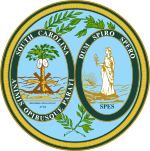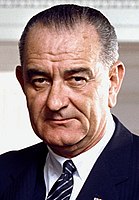1964 United States presidential election in South Carolina
| ||||||||||||||||||||||||||
| ||||||||||||||||||||||||||
| ||||||||||||||||||||||||||
| ||||||||||||||||||||||||||
| Elections in South Carolina |
|---|
 |
The 1964 United States presidential election in South Carolina took place on November 3, 1964, as part of the 1964 United States presidential election. South Carolina voters chose 8[2] representatives, or electors, to the Electoral College, who voted for president and vice president.
The swing away from Johnson was general except in a few areas of substantial black voter registration increases, and Goldwater's lowcountry dominance easily offset Johnson's narrow edge amongst the poor whites of the upcountry who, despite their hostility to Johnson's civil rights measures, saw Goldwater as a Dixiecrat-style conservative committed to privatization of services poor whites viewed essential.[3] After narrow losses in 1952 and 1960, Goldwater became the first Republican presidential candidate to carry South Carolina since Rutherford B. Hayes in 1876. South Carolina was one of five states that swung more Republican in 1964, alongside Louisiana, Mississippi, Georgia, and Alabama.
Background
[edit]Between 1900 and 1948, no Republican presidential candidate ever obtained more than seven percent of the total presidential vote[4] – a vote which in 1924 reached as low as 6.6 percent of the total voting-age population.[5] South Carolina was a one-party state dominated by the Democrats due to the disfranchisement of black voters.[6]
Following Harry S. Truman's To Secure These Rights in 1947, the following year South Carolina's Governor Strom Thurmond, led almost all of the state Democratic machinery into the States' Rights Democratic Party (Dixiecrats). As the Dixiecrat presidential candidate, Thurmond won 71 percent of the state's limited electorate and every county except poor white industrial Anderson and Spartanburg.[7] During the 1950s, the state's wealthier and more urbanized whites became extremely disenchanted with the national Democratic Party and to a lesser extent with the federal administration of Republican Dwight D. Eisenhower.[8]
Campaign
[edit]Roger Milliken invited Barry Goldwater to speak in South Carolina in 1959, and it was televised in the entire state. Milliken later financially supported Goldwater's 1964 presidential campaign.[9] During the 1950s, wealthy textile mill owners in the upcountry developed a grassroots state Republican Party dedicated to the tenets of the John Birch Society. This group nominated the most conservative delegation at the party's 1960 convention.[10] These wealthy businessmen would merge with hardline segregationists to draft Barry Goldwater for the Republican nomination in 1960 and join forces therein by the time of the next presidential election.[10]
U.S. Senator Strom Thurmond left the Democratic Party in September, to join the Republicans. Goldwater gave a televised speech in Columbia, South Carolina, that featured segregationist politicians on-stage with him, including Thurmond, Iris Faircloth Blitch, James F. Byrnes, James H. Gray Sr., Albert Watson, and John Bell Williams, in which he criticized the Civil Rights Act.[11]
The Democratic Party, for its part, had struggled bitterly over whether to select electors pledged to incumbent President Lyndon Johnson due to his support for civil rights and desegregation; however, like Georgia, Louisiana and Mississippi, South Carolina chose Democratic electors pledged to LBJ.[12] President Johnson did not campaign in the state, being hopeful that a black registration increased by more than Kennedy's 1960 margin[13] and support from economically liberal Senator Olin Johnston would help him win without campaigning.[14]
Early polls in South Carolina gave a substantial lead to Goldwater, but by the end of October, the state was viewed as similarly close to the 1952 and 1960 races where the Democrats won by under ten thousand votes.[15][16]
Goldwater received 70% of the white vote.[17]
Results
[edit]| Party | Candidate | Votes | % | |
|---|---|---|---|---|
| Republican | Barry Goldwater | 309,048 | 58.89% | |
| Democratic | Lyndon B. Johnson (inc.) | 215,700 | 41.10% | |
| Write-in | — | 8 | 0.00% | |
| Total votes | 524,756 | 100% | ||
Results by county
[edit]| County | Barry Goldwater Republican |
Lyndon B. Johnson Democratic |
Margin | Total votes cast | |||
|---|---|---|---|---|---|---|---|
| # | % | # | % | # | % | ||
| Abbeville | 1,448 | 35.00% | 2,689 | 65.00% | −1,241 | −30.00% | 4,137 |
| Aiken | 17,467 | 69.62% | 7,622 | 30.38% | 9,845 | 39.24% | 25,089 |
| Allendale | 1,740 | 69.27% | 772 | 30.73% | 968 | 38.54% | 2,512 |
| Anderson | 8,398 | 41.85% | 11,670 | 58.15% | −3,272 | −16.30% | 20,068 |
| Bamberg | 2,366 | 62.51% | 1,419 | 37.49% | 947 | 25.02% | 3,785 |
| Barnwell | 3,670 | 72.64% | 1,382 | 27.36% | 2,288 | 45.28% | 5,052 |
| Beaufort | 3,432 | 55.54% | 2,747 | 44.46% | 685 | 11.08% | 6,179 |
| Berkeley | 6,100 | 63.30% | 3,537 | 36.70% | 2,563 | 26.60% | 9,637 |
| Calhoun | 1,591 | 72.22% | 612 | 27.78% | 979 | 44.44% | 2,203 |
| Charleston | 32,509 | 69.06% | 14,564 | 30.94% | 17,945 | 38.12% | 47,073 |
| Cherokee | 3,627 | 46.00% | 4,258 | 54.00% | −631 | −8.00% | 7,885 |
| Chester | 2,915 | 42.89% | 3,882 | 57.11% | −967 | −14.22% | 6,797 |
| Chesterfield | 2,449 | 34.58% | 4,634 | 65.42% | −2,185 | −30.84% | 7,083 |
| Clarendon | 2,960 | 78.06% | 832 | 21.94% | 2,128 | 56.12% | 3,792 |
| Colleton | 4,637 | 69.33% | 2,051 | 30.67% | 2,586 | 38.66% | 6,688 |
| Darlington | 6,717 | 57.28% | 5,010 | 42.72% | 1,707 | 14.56% | 11,727 |
| Dillon | 2,742 | 49.72% | 2,773 | 50.28% | −31 | −0.56% | 5,515 |
| Dorchester | 5,109 | 76.11% | 1,604 | 23.89% | 3,505 | 52.22% | 6,713 |
| Edgefield | 2,489 | 75.13% | 824 | 24.87% | 1,665 | 50.26% | 3,313 |
| Fairfield | 1,997 | 43.18% | 2,628 | 56.82% | −631 | −13.64% | 4,625 |
| Florence | 10,346 | 59.11% | 7,157 | 40.89% | 3,189 | 18.22% | 17,503 |
| Georgetown | 4,705 | 57.89% | 3,423 | 42.11% | 1,282 | 15.78% | 8,128 |
| Greenville | 29,358 | 62.96% | 17,275 | 37.04% | 12,083 | 25.92% | 46,633 |
| Greenwood | 5,653 | 50.78% | 5,479 | 49.22% | 174 | 1.56% | 11,132 |
| Hampton | 2,259 | 61.09% | 1,439 | 38.91% | 820 | 22.18% | 3,698 |
| Horry | 8,293 | 60.37% | 5,444 | 39.63% | 2,849 | 20.74% | 13,737 |
| Jasper | 1,593 | 61.39% | 1,002 | 38.61% | 591 | 22.78% | 2,595 |
| Kershaw | 5,617 | 63.94% | 3,168 | 36.06% | 2,449 | 27.88% | 8,785 |
| Lancaster | 4,742 | 48.83% | 4,970 | 51.17% | −228 | −2.34% | 9,712 |
| Laurens | 5,081 | 53.79% | 4,365 | 46.21% | 716 | 7.58% | 9,446 |
| Lee | 2,489 | 68.29% | 1,156 | 31.71% | 1,333 | 36.58% | 3,645 |
| Lexington | 12,041 | 71.47% | 4,807 | 28.53% | 7,234 | 42.94% | 16,848 |
| Marion | 3,197 | 60.98% | 2,046 | 39.02% | 1,151 | 21.96% | 5,243 |
| Marlboro | 1,864 | 43.49% | 2,422 | 56.51% | −558 | −13.02% | 4,286 |
| McCormick | 939 | 65.34% | 498 | 34.66% | 441 | 30.68% | 1,437 |
| Newberry | 5,571 | 63.35% | 3,222 | 36.64% | 2,349 | 26.71% | 8,794[a] |
| Oconee | 2,712 | 32.79% | 5,560 | 67.21% | −2,848 | −34.42% | 8,272 |
| Orangeburg | 10,456 | 65.09% | 5,607 | 34.91% | 4,849 | 30.18% | 16,063 |
| Pickens | 5,882 | 62.63% | 3,506 | 37.33% | 2,376 | 25.30% | 9,391[b] |
| Richland | 27,306 | 60.35% | 17,939 | 39.65% | 9,367 | 20.70% | 45,245 |
| Saluda | 2,524 | 64.17% | 1,409 | 35.83% | 1,115 | 28.34% | 3,933 |
| Spartanburg | 18,411 | 47.89% | 20,034 | 52.11% | −1,623 | −4.22% | 38,445 |
| Sumter | 7,729 | 67.19% | 3,775 | 32.81% | 3,954 | 34.38% | 11,504 |
| Union | 3,815 | 49.50% | 3,892 | 50.50% | −77 | −1.00% | 7,707 |
| Williamsburg | 4,810 | 68.15% | 2,248 | 31.85% | 2,562 | 36.30% | 7,058 |
| York | 7,292 | 46.62% | 8,346 | 53.36% | −1,054 | −6.74% | 15,642[c] |
| Totals | 309,048 | 58.89% | 215,700 | 41.10% | 93,348 | 17.79% | 524,756 |
Counties that flipped from Democratic to Republican
[edit]- Berkeley
- Darlington
- Florence
- Georgetown
- Greenwood
- Horry
- Laurens
- Lee
- McCormick
- Marion
- Newberry
- Saluda
Notes
[edit]References
[edit]- ^ "United States Presidential election of 1964 - Encyclopædia Britannica". Retrieved May 27, 2017.
- ^ "1964 Election for the Forty-Fifth Term (1965-69)". Retrieved May 27, 2017.
- ^ Phillips. The Emerging Republican Majority, pp. 263–265.
- ^ Mickey, Robert (2015). Paths Out of Dixie: The Democratization of Authoritarian Enclaves in America's Deep South, 1944-1972. p. 440. ISBN 0691149631.
- ^ Mickey; Paths Out of Dixie, p. 27.
- ^ Phillips, Kevin P. The Emerging Republican Majority. pp. 208, 210. ISBN 9780691163246.
- ^ Frederikson, Kari. The Dixiecrat Revolt and the End of the Solid South, 1932-1968. p. 185. ISBN 9780807875445.
- ^ Graham, Cole Blease; Moore, William V. South Carolina Politics and Government. pp. 79, 81. ISBN 9780803270435.
- ^ "The Man Who Launched the GOP's Civil War". Politico. October 1, 2015. Archived from the original on September 19, 2023.
- ^ a b Mickey. Paths out of Dixie, p. 234.
- ^ Black & Black 1992, pp. 152–153.
- ^ Congressional Quarterly, Incorporated; CQ Congressional Quarterly Weekly Report, vol. 25 (1967), p. 1121.
- ^ Johnson, Robert David. All the Way with LBJ: The 1964 Presidential Election. p. 168. ISBN 0521737524.
- ^ Johnson. All the Way with LBJ, p. 224.
- ^ "State by State Rundown Shows Johnson Way Out in Front". The Morning Call. Allentown, Pennsylvania. October 31, 1964. p. 11.
- ^ Johnson. All the Way with LBJ, p. 275.
- ^ Black & Black 1992, p. 155.





